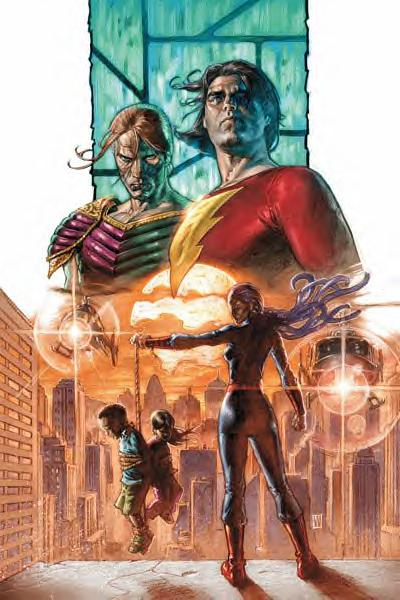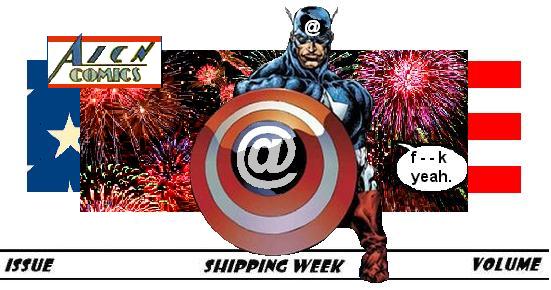
| #40 | 1/30/08 | #6 |

Greetings, guys 'n' gals, Stones Throw here with a very special Q&@ with writer and artist (as well as director and TV producer) Rob Schrab. Schrab created the 1990s cult hit SCUD THE DISPOSABLE ASSASSIN (with an assist from co-writer Dan Harmon), which chronicled the nihilistic adventures of a robot assassin programmed to self-destruct upon elimination of his target, before leaving its audience on a doozy of a cliffhanger and disappearing for ten years with its twentieth issue. Now Schrab has teamed up with Image to wrap up SCUD with #21-24, in addition to putting out a big-@$$ complete volume in June. #21 hits today (Feb. 6th) and I was lucky enough to get a chance to read the final issues and put some questions to Mr. Schrab. Be warned, some SPOILERS lie ahead…
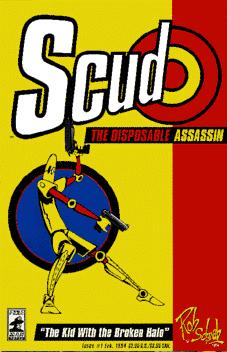 STONES THROW (ST): For those who might not know, what is SCUD and how did it come to be unfinished?
STONES THROW (ST): For those who might not know, what is SCUD and how did it come to be unfinished?
ROB SCHRAB (RS): Okay, our story so far…In the future, robotic assassins (or Scuds) can be bought from vending machines. The reason Scuds are disposable is because once they terminate their primary target, they self destruct--destroying all evidence. In the first issue, our Scud realizes he will die if he kills so he takes his mortally wounded target to the hospital and becomes a freelance hitman to pay for the life support bills.
SCUD ran for 20 issues. Along the way he met a human girl, Sussudio, who was a robotaphile (only has sex with robots) and they had a troubled relationship. In issue 20, Scud is hired by heaven to destroy the world. Scud refuses. The Angels explain to him that he is a robot fighting to stay alive yet he had nothing to live for. That is until he met Sussudio. Scud’s girlfriend is brutally murdered in front of him. The last panel of issue 20 had Scud saying “Okay…I’ll do it.” That was ten years ago.
ST: How did the opportunity to come back and complete the series arise?
RS: Couple of things. First Eric Stephenson at Image contacted me and asked if I’d be interested in them reprinting SCUD THE DISPOSABLE ASSASSIN in one big collection, then Shocker Toys wanted to do an action figure and...the fans. The fans kinda came out of the wood work. My name was being tossed around because of my work on MONSTER HOUSE and THE SARAH SILVERMAN PROGRAM, so I was getting a lot of “Hey, I remember you!” emails. I had a window open in my schedule and decided it was time. Feels good.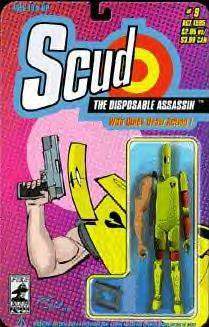
ST: How did you find getting back into SCUD’s world after so long? Any unforeseen difficulties?
RS: When I jumped in, it was like I never left. These characters were so close to my heart, it took about three hours to get back up to speed. Then the dam broke and I literally found it hard to stop drawing. As far as difficulties that I didn’t foresee, the biggest was me continually increasing the size of the last chapter. The book originally was going to be one 32 pager. Then it became 40, then 65, then 90, finally it ended up being 111 pages. My biggest comic project to date, a fitting end.ST: You’ve been pretty frank about your dislike of the direction the last few issues took. How did you reconcile this with wrapping up the arc in #21-24?
RS: I guess I was more disappointed with my attitude in the last couple of books. I look back at those books and see a lot of great writing by Dan Harmon and I was experimenting more with my art. I think I was just itching to do something else besides SCUD. I needed a break and I guess I...um, took one.ST: SCUD has more crazy ideas per page than Grant Morrison on a 9 day bender in Bangkok. What’s the creative process like when coming up with such whacked-out concepts and characters? Does it tend to flow or do you stare at a blank page for a while?
RS: People say my ideas are crazy and weird but I really don’t go out of my way to do that. I just write what I’d like to see. Sometimes I’ll throw a bunch of nutty stuff together and figure it out after the fact or it just sort of comes out of my head that way. Maybe I’m crazy. Is this how I find out? That would be funny. It all comes down to what makes me laugh, cry or say “That’s fucking awesome.”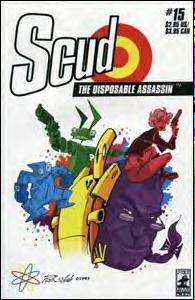
ST: The single issues often contained lists of suggested casting for the characters. Have you ever tried to get a SCUD movie or animated series off the ground and how did that work out?
RS: Few times. Oliver Stone wanted to make it into a movie in the nineties, I even signed a deal. That’s what got me and Dan Harmon out to Los Angeles. We wanted to write the script. But the studio didn’t want us because we were comic book guys and not screenplay guys. So when the option was up, I didn’t renew it.Couple years back I was working with MTV animation to do an animated series. That would’ve been great. SCUD would make a better TV show than movie anyway. I got so far with that one. I wrote the script, I was an executive producer, we were casting voice talent, shopping around for animation studios…then nothing. There was a shift in power up stairs at MTV and the new people didn’t get Scud. Too bad. Would’ve been fun.
ST: The last issue seems pretty conclusive, but is this the end of the line for SCUD? Nothing else on the horizon for the disposable assassin?
RS: I go back and forth but truly I think this should be the end. Maybe a one shot here and there but Scud needs to commit to this conclusion. But I am very excited about my new relationship with Image. They are so creator friendly. I really would love to kick out a brand new story with them.ST: As a British guy, the surreal and satiric blend of sci-fi and action in SCUD reminded me quite a bit of classic 2000AD. Just curious, do you happen to be a fan of any of those comics?
RS: I’ve read only a few Judge Dredds but if you are sensing any British influence at all you need to look no further than my obsession with Doctor Who. I’m such a nerd. I have Daleks all over my apartment.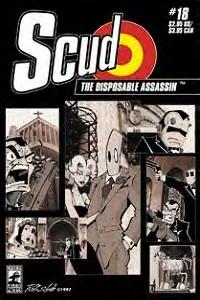
ST: As someone who’s worked in film and animation as well as comics, what would you say are the unique challenges and/or advantages of the comic book medium?
RS: When you write, draw and create a book it’s all you. It’s a lot like stand-up, it’s your ass up there (STONE: Schrab worked as a stand-up comedian while in art school). It’s thrilling and incredibly rewarding. You get to do anything you want. After working in the TV and film industry for ten years, it was fun to go back to that. It’s more like play than work.ST: You also co-wrote MONSTER HOUSE, which for my money was certainly the best kids’ film of 2006. What was that experience like?
RS: Thanks! Glad you liked it. MONSTER HOUSE was actually written ten years ago when I stopped doing SCUD. Harmon and I were upset that Oliver Stone’s company wouldn’t let us write the Scud movie so we put together a writing sample of our work and handed it around. The sample got into the hands of Robert Zemeckis’ people and we got a meeting. We pitched them this idea about a house that becomes a monster. We’ve been in the business ever since. It’s great to be a part of something that people enjoy. The new mo-cap technology is so amazing, I was on the ‘set’ and watched the kid actors jump around in suits with the balls all over them. It was really neat.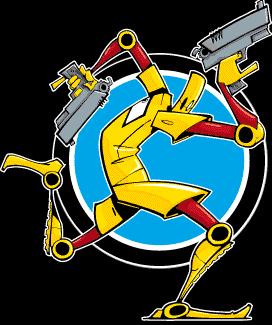
ST: Have you got any other comics projects lined up after the complete SCUD collection comes out in June?
RS: As I write this I am hoping the writer’s strike is over by next week so I can go back to work on the Sarah Silverman Program. I miss directing. Doing a TV series is very time consuming so I don’t think I’ll be jumping into another big comic project. I do have many ideas that I think would make great books. I don’t want to wait ten years again.ST: Finally, do you have any message for the SCUD fans who stuck it out for ten years for the conclusion?
RS: Sorry to keep you waiting. It will be worth the wait.ST: Thanks for taking the time to answer these questions.
RS: You’re welcome!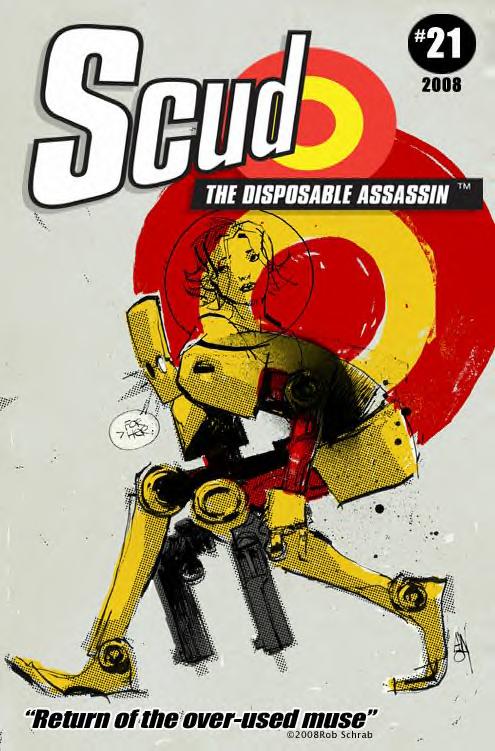
SCUD THE DISPOSABLE ASSASSIN #21
(in stores today) Words & art by Rob Schrab Published by Image Reviewed by Stones Throw
SCUD WILL FUCK YOU UP!Ahem. Every so often you happen across a comic book that, through the sheer amount of ideas and energy contained in its pages, reminds you of the often untapped potential in this bastard hybrid medium of pictures and words, and why you fell in love with it in the first place. For me, SCUD THE DISPOSABLE ASSASSIN was that kind of book. SCUD is a shock to the nervous system. I read the first four trades (issues one to 20) and the Image-published last four issues last week and I’m still buzzing—kinetic art, black humor, ultra-violence, satire, surrealism, and more ideas than you could shake a rabid Grant Morrison at, SCUD is the kind of book that’d enthuse even the most jaded fan.
In his punchy first issue, the pill-headed and permanently squinting Scud is set loose from his vending machine womb to take care of a mysterious monster that’s been terrorizing a mannequin factory (well, as far as I can make out). When the fight spills into a bathroom, Scud catches a glimpse of his warranty information in a mirror and becomes self-aware, realizing that if he kills the plug-headed, pop culture-quoting, multi-limbed mutant Jeff he’ll self destruct. Naturally, he decides he doesn’t want to die and hooks Jeff up to a life support machine, setting the stage for a series of adventures in which the personable Scud, paying the hospital bills as a hit man, stumbles from frying pan to fire over and over. Favorites included his team-up with Drywall, a charming kid sidekick covered in zips that lead to an extra-dimensional vortex filled with inanimate objects, which Scud, seeking refuge from the vengeance-fuelled Jeff dives into and…well, you get the idea. It may sound trite, but LOONEY TUNES by way of Alan Moore’s D.R. AND QUINCH and overseen by Sam Peckinpah is probably a good way to describe the book. Like a serial-killing Bugs Bunny, the deadpan and laconic Scud is a gleefully amoral anti-hero in the midst of all the insanity, a killer by design who, although he now has his mind set on slightly higher things, isn’t about to stop any time soon.
Now, for everything that SCUD did have in its first run of issues, one thing it didn’t was any sort of emotional depth. That’s fine and dandy with me: keep pussy emotions the hell out of my wild, Kirby-esque shoot-outs with disembodied werewolf-arms, sci-fi gangsters and evil, robotic giraffes! But that changed with the introduction of Scud’s love interest Sussudio towards the tail end of the first lot of issues. As you might expect with a character modeled after Gwyneth Paltrow (although I can’t really imagine Mrs. Coldplay playing this robotaphile killer), Sussudio wasn’t particularly interesting, but when she was slaughtered by renegade angels who wanted to enlist the gifted Scud to destroy the world in issue 20, the series got its first real feeling of emotional intensity to go along with the visceral punch of all the off-the-wall hijinks.
#21—not a bad place to start even if you’ve never read SCUD before, if you’re interested—runs with that development in emotional intensity and it’s a credit to writer/artist Schrab that I actually found myself feeling for these very stylized and completely off-the-wall characters in several places—not a mean feat when your lead character has a cylinder with two unmoving eyes and nothing else for a face. The tone is very much “cowboy returns home to find things aren’t as they should be” as Schrab wisely references the decade-long gap between issues by having Scud return to an Earth that’s become even darker in his absence. Darker? Well, this is a tale that focuses specifically on the character of Scud, rather than the previous run’s wider reach which could alternate between a teen slasher movie, a gangster soap opera or a broad satire of a disposable and amoral culture. There’s not so much of the light, madcap humor in these last four issues. There’s still the kind of humor of someone suddenly getting shot in the face (ultra violent slapstick), but the tone is bleaker and heavier, as well as being much more focused and polished than the sometimes scattershot (though that’s not necessarily a bad thing) early issues. Without belittling the anarchic fun of SCUDs past, this is a giant leap forward in terms of crafting a cohesive and involving read.
It also seems like Schrab’s drawing better than ever. There’s a kick-@$$ double page spread in #21, and things get tried in the storytelling and panel arrangements that don’t seem like they could have been done back in the original run. I was particularly impressed by one panel of Scud cradling Sussudio’s lifeless body in which Schrab really manages to sell the emotion of the scene—again, not a mean feat when your lead character’s face is a cylinder with two unmoving eyes and nothing else.
SCUD is a kick to the teeth and a shot in the arm that you’re grateful for. I’m a new convert but I found myself amazed and refreshed by the amount of energy and invention in the writing and art, and I couldn’t tear through the collected editions fast enough. And I’m pleased to say that Scud gets a fine send-off with the last set of issues, which bring his odyssey to a fitting end. The one thing I think I would compare SCUD THE DISPOSABLE ASSASSIN to for the uninitiated would be Jack Kirby when he really got to cut loose on the page. It seems like Schrab shares that same thrill of just being able to set loose concepts straight from the imagination and see where they take him—and also in the simple but symbolic themes explored with certain characters. I don’t know, I suppose the conclusion to SCUD lets the disposable assassin figure out that there’s something to this thing we call life and that some things aren’t disposable. Sniff.
Anyway, I can’t recommend SCUD more. It’s the perfect hallucinogenic antidote to the vast majority of today’s heel-draggin’, pretentious funny book reads. SCUD is a book that isn’t afraid to cut loose and show some balls—big, gold, metallic ones, that is.
Okay, I just creeped myself out.
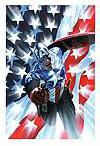
CAPTAIN AMERICA #34
Writer: Ed Brubaker Artists: Steve Epting (pencils)/Butch Guice (inks) Publisher: Marvel Comics Reviewer: Prof. Challenger
Steve isn’t leading the way up the battlefield…yet I can almost feel him here. But he’s guiding me now…instead of haunting me. I can’t be him. No one ever could. But I can try to make him proud…—the new Capt. AmericaThere’s an odd schizophrenia about Marvel Comics (well, and DC too) for the last few years. Rather than publishing episodic series that tell stories that move their characters forward within a shared universe, they seem more focused on marketing “events” that supposedly shake things up. The episodes in between these “events” all cynically serve the purpose of just filling time and space until the next “event.” Most of these series suffer from a scattershot style of storytelling, many times brought on by the fact that the creative teams are constantly shuffling around presumably because they’re either unwilling or unable to work within such a totalitarian editorial system. Yet each month Ed Brubaker and Steve Epting, with their work on CAPTAIN AMERICA, somehow make it seem effortless to produce one of the most tightly plotted, consistently well-written, and dynamically illustrated series published by Marvel.
This team succeeds even when the CAPTAIN AMERICA title is itself the source point for the marketing “event.” It doesn’t matter whether we’re talking about the much publicized death of Captain America or, in this issue, the slightly less-publicized introduction of a new Captain America outfitted with an all-new Alex Ross-designed costume. Both “events” flowed seamlessly within the ongoing serial that Brubaker is telling. It really should not be any secret to committed or even casual readers of this series who is under the mask in this issue, so I’m going to reveal it in the next paragraph – consider yourself spoiler-warned. Brubaker has been leading up to this moment for some two years and the payoff is just as solid and entertaining as each issue leading up.
The perspective that I tried to bring to this review was as someone who was a new reader with, at most, a basic knowledge of who Captain America is but without preconceptions. Ultimately, as a jumping on point I think the comic succeeds quite well. This is the beginning of Bucky assuming the role of Capt. America in the wake of Steve Rogers’ assassination and it just flat out works. As much as I or other fans might feel about Steve Rogers as Captain America, Brubaker has taken the concept of Captain America as a symbol rather than a person and run with it successfully here. Bucky brings his Winter Soldier training combined with his WW2 experience and perspective, as well as a true love and respect for Steve Rogers, and hesitantly accepts his role here as the inheritor of this mythic role. Flawed though he may be and lacking the super-soldier serum running through his metabolic system, Bucky picks up the shield, works with Stark to create a costume that gives him a bit more protection than chainmail, and outfits himself with military issue sidearms and weaponry. As the embodiment of Captain America, Bucky also takes on an unspoken Lone Ranger-style vow to use these weapons non-lethally in the battlefield of the streets of America. As a result, there are now at least three AIM agents recovering in the hospital from busted kneecaps.
Brubaker also incorporates quite a lot of Captain America’s publishing history into this one episode, but he does so in such a way that it seems natural and doesn’t need a lot of backstory to explain it all. I’m talking about organizations such as AIM and characters like the Red Skull, Arnim Zola, and Dr. Faustus. The skillful use of these characters along with Bucky and Tony Stark, I feel, fully embrace aspects of Cap’s entire publishing history and establish them all as relevant today as they were when they first appeared. On that level this is really good stuff that any fan of pulp action thrillers as well as realistic super-hero comics should enjoy.
Structurally, Brubaker’s story unfolds more like a TV action/drama than your average comic book. It’s a writer’s choice that works well with Captain America because it grounds these fantastic characters in a world that seems just a bit more realistic than your average Marvel comic. And I believe that degree of realism, heightened by the moody shadows that Epting’s art revels in, would appeal to readers not weaned on super-hero comics. In fact the dark and moody art is reflective of the modern world that Cap functions in today full of public discontent, governmental distrust, and terroristic mind-control culminating in a shocking last page that will have serious long term ramifications.
Now as to the new costume, I understand that the overall fan reaction (at least what I’ve seen online or overheard in public) has been one of disdain for Alex Ross’s new design. From my perspective, I don’t think any radical redesign of any iconic character is ever widely accepted by the fan base, so it really doesn’t matter that I kind of like it. But I do. It’s not what I would consider the best way to go with a redesign but it sure as heck beats the old Nomad costume or the Cap and costume that eventually became U.S. Agent. The idea that a less powerful person under the cowl might need a bit more protection and having Stark help design a lightweight armored tunic and mask makes a lot of sense plus the type of gloves he’s wearing are an apparent nod to the Cap costume of the movie serial of the 40s – and that’s kind of cool. The costume is a bit more practical minded for urban battles than the other more iconic costume and I can appreciate the thought that went into it. For as long as Bucky is under the cowl, I’m good with it but I’m not so sure I’d like to see the inevitable return of Steve Rogers include this newest costume.
I recommend this comic as a good point to start reading CAPTAIN AMERICA and if you’re intrigued enough, maybe it’s time to pick up the trades and fill in the back story on Brubaker’s outstanding run.
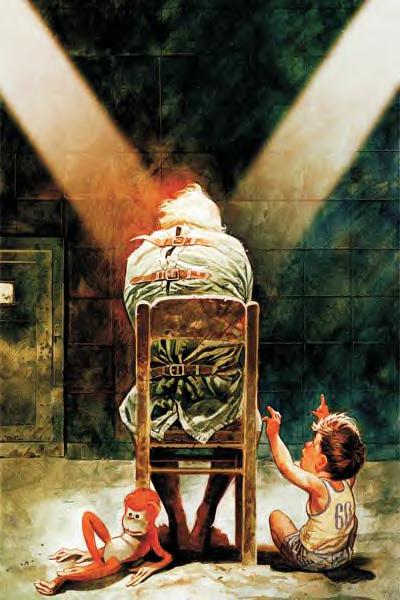
Y: THE LAST MAN #60
Writer: Brian K. Vaughan Penciler: Pia Guerra Publisher: Vertigo/DC Comics Reviewed by Humphrey Lee
Alas, poor Yorick, I knew... errrr... y'know what? Yeah, let us not cash in on that. No reason to resort to cliche when celebrating the passing of one of the best comic book series of the Modern Age. Mainly I was just going for the irony of how a comic book the caliber that Y has been also emerged from a cliched saying itself: "Not if you were the last man alive", a phrase that haunts my memories of college...Alright, cliches and horrible jokes aside, I'm here not so much to review this heart wrenching finale as I am to pay tribute to the series. So, don't worry, there won't be any huge spoilers for you heathens that have enjoyed this book solely in trade form (which, okay, is admittedly the best way to read it). See, the thing that made Y so special for me is that it's the first of these "Finite Epics" like the PREACHER's and TRANSMETROPOLITAN's and SANDMAN's of the industry that I got to see all the way through. Typically in the case of series like the ones I mentioned before, I might have seen the end of them as they occurred, but usually I didn't get a chance to jump on them in issues since I didn't even get back into comics until they were halfway or almost completely done and I caught up with the TPBs. I've been here with Yorick Brown and his merry band of world travelers since issue #1, and now that it's over, not to be overly weepy about it, I really was choked up with this finale.
Obviously the main story backdrop for Y was the plague. When you have a plot involving the death of almost everything with a Y chromosome on the planet, obviously that's something that you have to give a lot of your page count to developing. But to me, and I think given how BKV had handled the source of the plague more towards the end of the series this might be the case to him as well, the death of all the men was really secondary to the characters, especially Yorick. To me Y: THE LAST MAN was more a story of a young man growing up and finding his place in the world, it was just taken to the Nth Degree with all the sci-fi wackiness and political intrigue that invaded his world because of what he had become: the world's last hope of survival.
In a way, I've grown up with Yorick Brown. Another reason I latched onto the book when it began is that I'm pretty much the same age as the character. I had just turned 21 way back when it hit the shelves and as I write this I'm a summer away from 27, about where young Yorick was when the "Present Day" ending of Y happened in issue #59. As he's gone out to see the world, I've done my own bit of exploring. Obviously I haven't had a grand adventure on the level that he has, but as far as the level of self-discovery our young protagonist has done post-plague, well, I like to think I've done similar. And after seeing this last issue, I even think he has helped me decide to resolve my own apparent "folically-challengedness" as he and his creator have: with a razor and a lot of shaving foam.
What really sold me on this book, this work as a whole, was the "Safeword" story arc. Up until then, Y to me had been an intriguing look at a post-apocalyptic world with some quirky and lovable characters and, of course, one pain in the ass monkey. But that arc, where Yorick finally came face to face with exactly who he was as a person, the turmoil that he was combating deep down in him, that was the first time I knew exactly how brilliant this book was and would continue to be.
Now that it's all said and done, and I'm standing here at the end of it all, I can say that it all paid off in the end. Yes, we're left with some questions, and yes maybe the plague itself was treated more of a MacGuffin then it should have been, but all in all Y still turned out fantastic and something I hope to reread on hopefully a yearly basis: easily one of the best comics this decade, and this isn't a period lacking for them. At the very least I love the characters just that much that I want to spend time with them again, or at least that's what the little pit of dread in my stomach told me as I closed this last chapter that came out this week. As the finale did what it did, as we got all those little bits of closure, it was like watching old friends drift away. And the moment with Ampersand in the middle of the issue: Absolutely priceless. I actually had to stop there for a moment it was so perfect, just like this last chapter was on a whole.
And, to start to wrap this up, I'd be remiss if I didn't talk about Pia Guerra's work on this title. Honestly, without her pencilwork (and a little help from Jose Marzan Jr. and Goran Sudzuka and others) Y: THE LAST MAN is not the comic it was at all. Quite frankly it's just the way I feel comic book art should be done. It's all so perfect: the line work, the detail, the expressions the panel transitions - everything is so crisp and there's so much craft on every page and it’s astoundingly consistent for sixty issues. This is the kind of "superstar art" that should be selling books out there and something so fantastic I hope to own it in an oversized form some day. Many thanks as well to J.G. Jones and Massimo Carnevale, whose covers have really lit up these issues as well, particularly on this finale. They always made me eager to crack into this book whenever it showed up. Amazing stuff.
Y: THE LAST MAN was a gift to the comic book world, and it's saddening to see it go, but that's the appeal in comics and stories such as this. It doesn't go on for decades, there are no "retcons" and the universe doesn't get restarted after some universal struggle. The characters live, they die, and you accept it and you move on. Sometimes, most times, there's a Happily Ever After, and sometimes things don't work out as you would hope. And sometimes things just are what they are. That's life, that's the world we live in, and that was Y: THE LAST MAN. Here's to a little more than five years of comic book excellence. I don't know if the team that gave us this can top it, but I sure as Hell hope they try. Cheers...
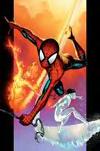
ULTIMATE SPIDER-MAN #118
Brian Michael Bendis: Writer Stuart Immonen: Artist Marvel Comics: Publisher Vroom Socko: The Fantastic Mr. Frump
Let me get this out of the way first: I’m not a big fan of Spider-Man and his Amazing Friends. Really, it’s the hidden computers I had issue with as a kid. This is Spidey, after all, not Batman. He’s supposed to be an everyman hero, right? Hidden computers… what’s next? Is Peter going to develop phenomenal cosmic powers, or have a long lost cloned twin, or sell his soul to the devil?Oh… Oh right.
Well, that grievance aside, I do like one thing about the show. These three aren’t a team in the strictest sense; they’re a group of friends. Spidey as a team member is something that never worked for me, but as a guy who works with and is helped by his friends… That’s Spider-Man right down to the core. Which brings me to the latest effort from the esteemed Mr. Bendis.
After the death of the Osborn family last issue, this one is a welcome breather. Plotwise, it is a bit predictable, being a beat for beat homage to the first installment of the Spidey/Human Torch story from fifty issues ago. The main difference being that instead of Johnny Storm bursting into flames at the end, it’s Firestar. The Old-School New Warriors fan in me is a bit disappointed that this Firestar isn’t Angelica Jones, but I do like how Bendis seems to be playing her off as an amalgam of Firestar, Frankie “Nova” Raye, and a character I will not spoil but readers can probably guess. I also like the way this pays off a character quirk that’s been building for a hell of a long time. It makes total sense from a story standpoint, and it works perfectly.
What also works perfectly is Stuart Immonen’s artwork. Comparing the situations in this issue to the similar ones in issue #68 is like a revelation. Mark Bagley is the finest and most iconic Spider-Man artist of the past decade, especially when he draws Pete swinging from a thread, but when illustrating teenagers being teenagers, Immonen has him beat hands down.
What makes this issue work though, what makes it a damn fine bit of storytelling even with the familiar beats, is how Bendis handles all of Spider-Man’s amazing friends. I’m not talking about Iceman here, who at this point is really an amazing acquaintance, but all of the characters we’ve seen at Peter’s side for the past 120 issues, who are at his side now to help him deal with the loss of Harry. The real kicker is that the most amazing of his friends are the ones without any powers. In particular, there’s the one friend whose loyalty is an almost touching surprise. That’s what makes this a great issue. It’s the understanding that Bendis has about not just dialogue and character, but how important Peter Parker’s friends are to his life, be they in costume or just average Joes.
It’s telling just how great this issue is told that when I put it down, I wasn’t thinking about editorial mangling, or crossover fatigue, or how if I never hear the word Skrull again it’ll be too soon. When I put it down, I was thinking about Peter and his friends, and how amazing they are. And I was thinking about my friends, and how amazing THEY are. And I was thinking that issues like this are the reason I respect Bendis as a storyteller.
Oh, and I’m calling it right here that Pete’s going to come clean with the few friends that don’t know he’s Spider-Man very soon. Probably next issue soon. Not because half the goddamn Ultimate Universe knows it already, but because they’re his friends, damnit. They deserve to know.
This issue… This issue is the good shit.
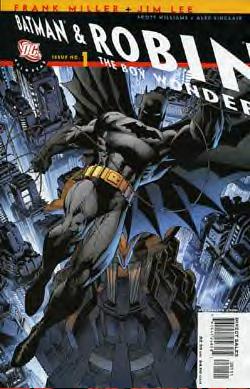
ALL STAR BATMAN & ROBIN THE BOY WONDER #1-8
Writer: Frank Miller Art: Jim Lee Publisher: DC Comics Guest Reviewer: barking_frog
Miller and Lee's new BATMAN has been in publication for over two years now. In that time, eight issues have been released, making it effectively a quarterly rather than the monthly that was originally planned -- in fact only one issue of ASB&R was released in all of 2006 [ Wiki '08Jan30]. I know this because I read comics in blocks, and I've been waiting impatiently for enough of the story that I could read a large piece all at once.Over the past two years, critics and fans have for the most part reviled Miller's writing on the series, posting one negative review after another.
So I was fully prepared for the series to be awful. Between Miller's middling-quality DARK KNIGHT RETURNS sequel THE DARK KNIGHT STRIKES AGAIN in 2001-2002, and the outrage about ASB&R, I expected the man had lost his touch. The reason I picked up the series at all was -- well -- Frank Miller's Batman. If you were around in '86 for DKR, you know what I mean.
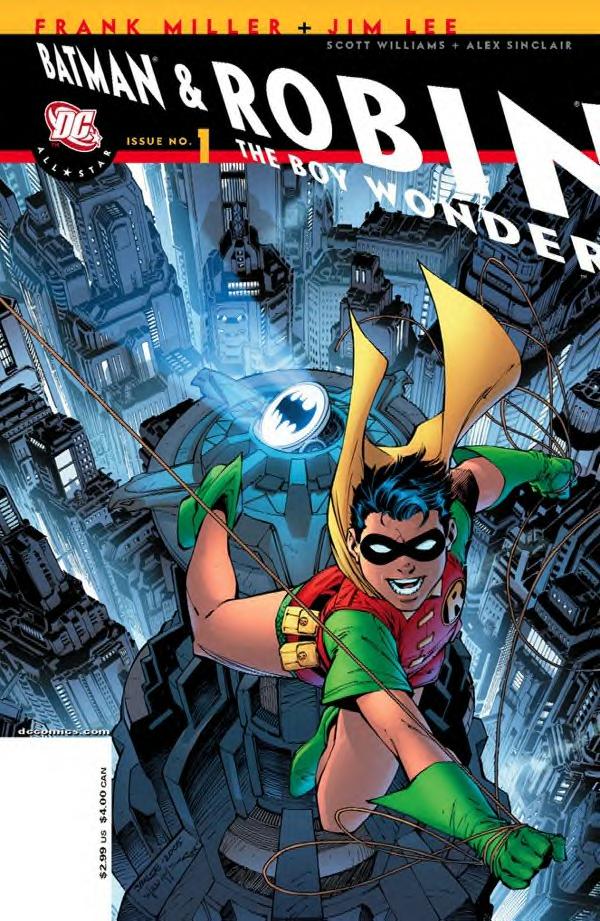 ASB&R is the best comic I've read in a long time.
ASB&R is the best comic I've read in a long time.It is not a comic for people who are new to comics -- which might mean it's mismarketed, since I understand the point of the All Star books, in part, is to provide a continuity free jump-on point for new readers after the fashion of Marvel's Ultimates line.
It's also not necessarily a comic for returning readers, or readers who treasure the traditional interpretations of their favorite characters.
ASB&R is a comic for a very small audience, and I'm sure that's part of why it's being widely perceived as a failure. But if you're part of that audience, this story is simply amazing.
To truly appreciate what Miller appears to be doing, I think it's necessary to understand quite a bit of the comic book medium's history, its characters, its storytelling conventions, and even its fans. I think Miller begins ASB&R with the intent to shock and offend readers -- and judging by public response he's succeeded. But, putting some pieces together, I believe Miller might be laying the groundwork for one of the greatest character-oriented Batman stories we've seen yet.
Taken in a vacuum, ASB&R appears to be self-parody. But consider that Miller has stated he intends ASB&R to fit within his larger Batman chronology that begins with YEAR ONE and ends with DKR and its sequel.
YEAR ONE and DKR both show us fundamentally the same Batman. Driven, canny, a strategist, highly rational, terrifyingly sane in an insane world. But ASB&R -- and this is one of the major objections readers have raised in response to the series -- shows us a Batman who is like a mentally/emotionally handicapped child, changing his story as he tells it, hopelessly infatuated with himself, psychotically violent. This Batman is what we'd get if the picked-on nine-year-old who wants to grow up and be Batman so he can terrorize the schoolyard bully were to, in an instant, get his wish.
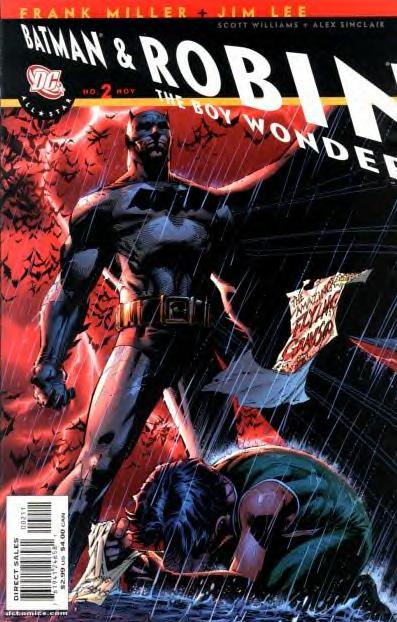 How can these two Batmans be the same character?
How can these two Batmans be the same character?I think Miller has started with a seeming incongruity that's actually the setup for what may grow into an excellent character study.
Looking ahead to DKR, there's minimal reference made to Dick Grayson/Robin -- but something notable halfway through DKR issue #2, in the scene in which Batman is suffering a severe beating at the dump, is Batman's reference to Grayson as "my little monkey wrench". Within the larger context of the scene it's possible to perceive a relationship that dovetails with what we're seeing in ASB&R.
A recurring question in Batman mythology is why, exactly -- in the real world -- Batman would ever need a Robin. I believe Miller is going to suggest that Robin is what keeps Batman grounded and sane, and that what we're seeing at the beginning of ASB&R is a Batman a year or three beyond YEAR ONE, after he's had time for his life in the shadows to wear away his sanity.
Examined in this light, the ASB&R Justice League's concern over Batman makes sense. Batman's violence makes sense, his self-infatuation makes sense, his childishness makes sense. His need to impress, paired with his remoteness, makes sense. His apparent fall from the subtle detective of YEAR ONE makes sense. Robin's disgust with him makes sense.
Reread the two pages at the end of the DKR #2 dump scene, and it's easy to imagine ASB&R in the background.
Miller isn't showing us a Batman who seems insane, he's showing us a Batman who is insane.
I believe all this will be by way of showing a gradual and developed maturation of the two iconic characters. I suspect Robin will evolve from feeling disgust for this damaged, crumbling, tragically needy Batman, to feeling admiration for the hero underneath the present wreck of a man, and will perhaps become bound to him by deeper knowledge of the man underneath the hero than maybe anyone else could be. I suspect Batman in turn will, through his relationship with Robin, regain his equilibrium and evolve into the figure we see in DKR.
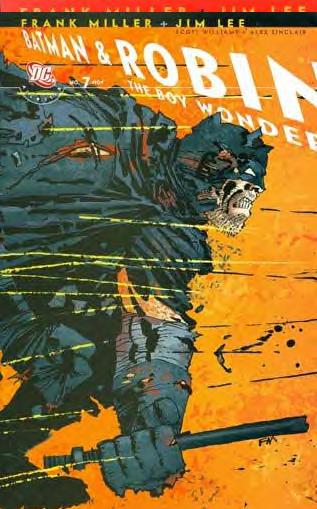 In fact, in DKR we can see hints that this younger, less sane Batman might be something Miller always had in mind -- but only hints, as though the ASB&R period in the character's life would be one he'd bury or reinterpret as necessary to heal himself later. When compared to events so far in ASB&R, events in Batman's memories in DKR already indicate the kind of reinterpretation he might've engaged in if he'd succumbed to insanity in his ASB&R past. Either Miller has always seen Batman as a character who at one time lapsed into madness, but didn't give us enough context to understand this in DKR twenty years ago -- or he's found a brilliant way to write a completely original Batman in the present without contradicting what he's already written in the character's future. Two examples of the DKR memories I refer to, both from the aforementioned dump scene, include Batman's on-the-fly rewriting of Robin saving his life into him saving Robin's life, and his recollection that Robin gave the Batmobile its name -- a name we discover our childish ASB&R Batman in fact gave it ("kind of name a kid would come up with") and with which he is visibly impressed, but which twelve-year-old Robin considers "totally queer".
In fact, in DKR we can see hints that this younger, less sane Batman might be something Miller always had in mind -- but only hints, as though the ASB&R period in the character's life would be one he'd bury or reinterpret as necessary to heal himself later. When compared to events so far in ASB&R, events in Batman's memories in DKR already indicate the kind of reinterpretation he might've engaged in if he'd succumbed to insanity in his ASB&R past. Either Miller has always seen Batman as a character who at one time lapsed into madness, but didn't give us enough context to understand this in DKR twenty years ago -- or he's found a brilliant way to write a completely original Batman in the present without contradicting what he's already written in the character's future. Two examples of the DKR memories I refer to, both from the aforementioned dump scene, include Batman's on-the-fly rewriting of Robin saving his life into him saving Robin's life, and his recollection that Robin gave the Batmobile its name -- a name we discover our childish ASB&R Batman in fact gave it ("kind of name a kid would come up with") and with which he is visibly impressed, but which twelve-year-old Robin considers "totally queer".In a sense, then, after nearly 70 years of stories about Batman saving Robin -- I believe Miller is setting the stage to tell us the behind-the-scenes story of how, over possibly several years early in their career together, Robin was responsible for saving Batman.
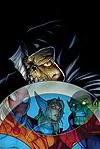
AVENGERS: THE INITIATIVE #9
Writer: Dan Slott/Chris Gage Artist: Stefano Caselli Color Art: Daniele Rudoni Publisher: Marvel Comics Reviewer: Rock-Me Amodeo
I can sum this comic up in one word: “Interesting.”But two words is better: “Holy crap!” (Side note – after I finished writing this review, I went looking to see what other people thought, and the first thing I found, startlingly, began with “Holy Crap!” How prescient of me!) Because those words, and more, is what you’re probably going to be saying multiple times before you finish reading.
I always thought this book would turn dark, but I never really expected it to go the full Monty. I suppose I was thrown off by the pencils, which seem more suited for, say, an upbeat Spiderman book where, uhn, no one dies and the status quo is pretty much maintained. (Slott writes a book like that, too? You don’t say!)
No such status quo here. Heck, not only do new people buy the farm, but I’m wondering if some older folks are going to make it out alive. In the course of these events, some of the lesser characters get a little time in the spotlight, like Thor Girl (ugh, hate that name) and Cloud Nine(being written like a real person, of all things) and Crusader (someone needs to give him a hand.)
Some better known characters also get good face time. I’m not sure I like Hank Pym going all “Mr. Military” and “son” and “I’m your commanding officer” and stuff. Commanding officer…I mean, really: what rank exactly does he have? I’m guessing Slott never served in the military. But that’s okay, Pym didn’t either, so it’s kind of fitting that he talks like someone who is trying to SOUND like they’re in the military. (I know most people wouldn’t care, but I mustang-ed my way from E-5 to O-2, so that military stuff always resonates with me.) But almost any personality for Pym is better than the pathetic puss-bag he normally acts like, so I’ll take it. It was also good to see Beast and Dani.
Others characters, like Taskmaster, show that when the going gets tough, they will stay true to type. I don’t really care for the way we see more and more villains being treated by the good guys as simple assets-for-hire. If they’re going to be around, I appreciate them being written in the manner Slott writes them: not as mere super-powered opportunists, but as a fundamentally selfish and cowardly lot. I know that Marvel practically invented the sympathetic villain, but I still want my villains to BE bad guys, sympathetic or not. I know, I’m old school.
So where does that leave us with MVP/KIA? Well, he does generate a certain amount of sympathy. But he is the villain of the piece, no question. He’s got to be put down. And the Initiative, or at least Camp Hammond, will go down too. In flames, I’m guessing, which would be QUITE ironic.
I loved the idea of a training camp for heroes. Why did it have to include such rotten elements in the beginning? But it did, and the seeds of its demise were planted in the very first issue. I will be sad to see it go. But if it stays as good as it has been, THE INITIATIVE will last a lot longer than Camp Hammond. I hope so. This book is easily the best thing to come out of CIVIL WAR.
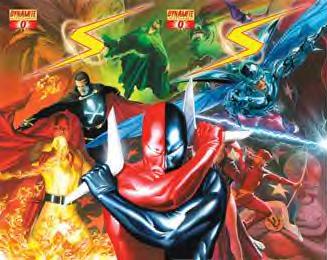
PROJECT: SUPERPOWERS #0
Writers: Krueger, Alex Ross Art: Alex Ross, Klauba and Sadowski Publisher: Dynamite Entertainment Guest Reviewer: Optimous Douche
I hate magic. I hate magic in all of its permutations both in the real world and comic books. My hatred for magic in the real world stems from my utter disbelief in the susceptibility of the masses. Not only does David Copperfield seem like a douche of epic proportions, but if he could make the Great Wall of China disappear, don’t you think he would have a higher calling in life than performing three nights a week at Caesar’s Palace?My hatred for magic in comic books stems from the fact that editors (that’s you Joey Q) and writers often use it as an easy out and a quick fix. Unless you are mildly retarded or shop for your comics at Borders, you know how magic has single handedly destroyed the continuity of Spider-Man with “Brand New Day” (which personally I think is a title better suited for a Christian rock album). On the other side of the big houses, I personally want to burn every issue of JUSTICE LEAGUE in which Zatanna appears. “The monster has defeated Superman, Batman and Green Lantern! Quick, someone find Zatanna to come say Go Away backwards.” You might as well just rename the book THE GO AWAY LADY AND HER SPANDEXED ENTOURAGE.
I swear that I do have a willing suspension of disbelief; the forty long boxes that occupy the man-cave of my house is proof of that. But if you are going to use magic as a story convention then you better do two things: give it one hell of a back-story and don’t make it easy.
Well, the Lovin’ Spoonful will be very happy, because after reading the 0 issue of Alex Ross’ much anticipated (I know, “with great art, come greater delays”) SUPERPOWERS, I can say emphatically that I do believe in Magic.
It seems like WWII is popular this year. A few weeks ago we were treated to THE TWELVE, where JMS resurrected a slew (OK twelve) of the 1940’s most forgettable funny rag champions. With SUPERPOWERS we are treated to another tale that focuses on the war to end all wars, but this time instead of science being the chief catalyst the story focuses on the most terrible box ever unleashed on man (no, not Britney Spears) – Pandora’s Box.
The premise of the story is that all evil unleashed on the world is a direct result of this terrible box being opened. For those that don’t know history Ross stole this idea directly from Sophocles’ first comic ZEUSMAN AND THE G-FIGHTERS. Ross’ twist on this timeless old tale is that Pandora’s Box is not a box, but rather an urn. And not only does Pandora’s Urn posses all of the world’s evils, but the forces of good are the sealant on top that keeps evil trapped inside. Remember, the Greeks did not have professional morticians or crazy glue--they had to seal their urns somehow.
Army intelligence believes that Hitler not only has The Bomb, but also The Box, I mean The Urn. They have also stumbled upon this ancient tale of the Urn’s true nature. They turn to the one hero they know they can trust with this information, America’s champion, The Fighting Yank (which is how I referred to my sex life when I broke my right hand in ’97). The Yanks’ mission (does that make anyone else giggle?) is to infiltrate Hitler’s stronghold, steal the urn and use it to not only harness evil, but to also get all of the heroes of the world to agree to commit herocide to ensure that evil stays put.
I won’t say whether he succeeds or fails in this mission, but I will say this book isn’t a one shot, so use your imagination (not many superhero titles succeed without heroes).
When the elements of the story are dissected separately they might sound contrived, but when mixed together they actually make for a rather interesting and complex tale. I feel the same way about this book that I do about the taste of carrots. I despise the taste of carrots by themselves, but when mixed into my wife’s pumpkin/shrimp soup the mild hint of the carrot brings the dish to life. Ross’ interweaving of magic, mythology and history will keep me waiting with baited breath for the next issue.
The art, as you can imagine, is superb. Even though Ross only steps in to pinch hit on the cover(s) and a few select splash pages, Klauba and Sadowski do an admirable job of emulating his style without outright ripping him off.
Aside from a few battle splashes and watching an Octogenarian version of the Yankster run away from a possessed cape, this issue was not high on the action scale. However, with all of the complex story elements that Ross had to set up in this issue, I’m willing to cut the Dynamite boys some slack.
I will gladly start plunking down my $2.99 for future issues of this book, since I’m sure the $1.00 price for the inaugural issue won’t be on the cover of issue 1.
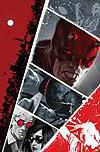
DAREDEVIL #104
Written by Ed Brubaker Art by Michael Lark, Stefano Gaudiano, Paul Azaceta, Tom Palmer, probably a few other guys too. Published by Marvel Comics Reviewed with retorts by Stones Throw
“Yer not reviewing this book again, Stoney?”You may or may not know that I’ve been a pretty big fan of what’s being done on the Man Without Fear these days. Bru and Lark managed to clear up the Bendis secret identity kafuffle with some beautifully in-continuity maneuvering and have generally been crafting cool new DD stories to fit into the pantheon of ‘em. For me, their run reached its apex thus far with the previous arc, which featured Matt Murdock’s old nemesis the Gladiator and a new drug sweeping the streets of Hells’ Kitchen, and was intelligent, modern super heroics at its finest. How can you not love a book that brings the Enforcers back complete with classic costumes and personalities and doesn’t make it a joke?
“I dunno.”
If you’re deranged, that’s how. But despite my general satisfaction, the last few issues have sat a little less easy. In fact, I had more than a few problems with this latest one.
“So spill.”
A few issues ago, DD’s wife Milla (a.k.a. Blind Girlfriend) was drugged by an early nemesis of his, Mr. Fear, and pushed a man in front of a subway train. Since then she’s been in and out of psychiatric wards and things aren’t looking good on the sanity front. In this issue, tensions mount for our hero, and pushed to the brink and searching for answers and a cure, he chains the Ox up and takes a blowtorch to him.
Yup, Daredevil, the star of the book, tortures a villain on-panel. I mean, not even a proper villain, more like Lenny from OF MICE AND MEN as a super-powered bad guy. Sure there’s other stuff, like Milla suffering a relapse and almost beating her nurse to death, but that’s what really got me hung up. They give us the “I don’t enjoy torture, but tonight I don’t care…I don’t even wonder what that says about me” narration, but there’s no denying that the line of what should go in an all-ages, main-line Marvel comic was crossed, and editorial wasn’t there to hold them back. I’m pretty sure a scene like that wouldn’t swing a rating lower than an R if this were a movie, and it’s completely unwarranted in what really should be a child-friendly universe. In that Spidey Roundtable the @$$holes put together a week or two back I commented that it’s depressing that Marvel are now completely pricing kids out of the monthly adventures of their most famous hero by going thrice-monthly, and by the same token I find it sad that the advisory rating on most of their books is 13 and up, because I’m sure most of us were a lot younger when we first got hooked on superheroes.
“Ah, come on! It’s the deep, profound, makes-yer-heart-swell-up drama, jerk-@$$!”
The scene doesn’t even work dramatically. Daredevil’s pushed to the brink, yet it’s already been established he knows what he’s doing is wrong, and that he’s going to regret it. So what’s the resolution? DD learns that taking a blowtorch to defenseless guys is okay if it gets good results, and he, Foggy and Milla all sit down and chuckle about it? Or do things descend even further, by which point I’ll completely lose interest and they’ll have ended up with an unsympathetic and unrelatable character? Or, as is more likely, do we find out that all this is down to Mr. Fear’s…Scarecrow gas…in which case I’m left wondering what the point was in the first place, other than to tar Daredevil with some unnecessary out of character actions? I mean, Frank Miller told probably the best DD-pushed-to-breaking-point story in BORN AGAIN, and while I’m not saying I don’t have a problem or two with those comics, I never lost sympathy with Matt Murdock or felt Miller had acted against the central tenets of the character.
“Central tenants? Since when did Daredevil become an apartment block?”
Like Matt Murdock fundamentally being a stand-up guy? Daredevil is one of Marvel’s most human characters, and his world often contains potential for more grounded stories. But I, and I’m sure many others, are drawn to comic book superheroes because they embody man’s best qualities and fight for more noble things. You’re telling a story that pushes DD. It’s been done many times before. But don’t betray what the audience knows about the character in favor of cheap shock.
“Yer missing the point. Daredevil’s being pushed into acting against his morals. You’re meant to feel uncomfortable.”
There’s still the highest level of craftsmanship, both in the art and writing on this title. But I’m beginning to feel that in trying to make things intense for Hornhead, Brubaker and Lark are vastly over-stepping the line of what fits in a classic Marvel book. The whole plot going on with Milla is veering dangerously close to WOMEN IN REFRIGERATORS territory, and I think her character is probably beyond the brink of being tarnished by her actions. Now Daredevil has got in on the act in this issue, and really, I can’t see the point. We know he doesn’t like torture, and we know he’s gonna regret it. It’s a moot point, and it’s dull and ugly to read. Let’s get back to exciting stories that use the character well, ’kay?
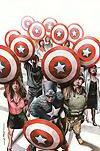
CAPTAIN AMERICA: THE CHOSEN #6 (of 6)
Writer: David Morrell Artist: Mitch Breitweiser Color Artist: Brian Reber Publisher: Marvel Comics Reviewer: Rock-Me Amodeo
I’ve been thinking about death lately. Not the normal kind of Marvel death, where no one stays dead except…uhn, scratch that. I mean real death: that unpredictable, inexorable crush of entropy which eventually catches up to all of us. You know, despite all the advances in medicine and science, the mortality rate is still 100%. It’s just a matter of when you pass…how you pass…and with how much class, if that last matter is within your control.Like the original Samson pleading, “Just one more time, Lord.” Like Darth Vader, who wanted nothing more than to redeem himself in that last act of courage. Everyone wants a shot at redemption, right? That’s what pushed the first fantastic years of THUNDERBOLTS. That’s what kept “Angel” full bore for five seasons. It’s poignant. It’s touching. It’s tragic.
How much more tragic, then, when the character doesn’t need redemption? When their last selfless act is simply one of many? How much more awful is that? Well, I can’t tell you exactly. But maybe you could experience it yourself.
I’ve been reading this series from the beginning, and thought I knew what was coming. But I was still surprised and touched when we got there. I’ll warn you: the series started slow. I can’t tell you where in continuity it is (it sure ain’t “now.”) I was apprehensive when I started, as it felt very “What Iffy”, ala BULLET POINTS. But somewhere along the way, I began to vest in the story. Yes, the word “powers” might have been mentioned too many times. Yes, the main premise was repeated once again as part of the story. Minor nits. The overall story was excellent.
And it goes like this: at some point, beyond Steve Rogers’ inevitable comeback, he eventually begins to die for good. But it’s not really his story. It’s the story of Corporal James Newman, picked as Cap’s probable successor.
There you go. Simple. Straightforward. Surprisingly uncomplicated. Just like the art. Just like the writing. Just like Captain America. And just as compelling.
I’ve been thinking about life lately. Not the normal kind of Marvel life, full of explosions and impossible coincidences. I mean real life: the kind of life you lead after someone close to you passes away. It’s a matter of what you learned…how it changes you…and the class with which you choose to continue on, if that last matter is within your control.
But in this series, Morrell was firmly in control, and that’s a good thing. Someone’s going to die. Someone’s going to live. I knew that. But in the end, I was unexpectedly moved. You may be, too.

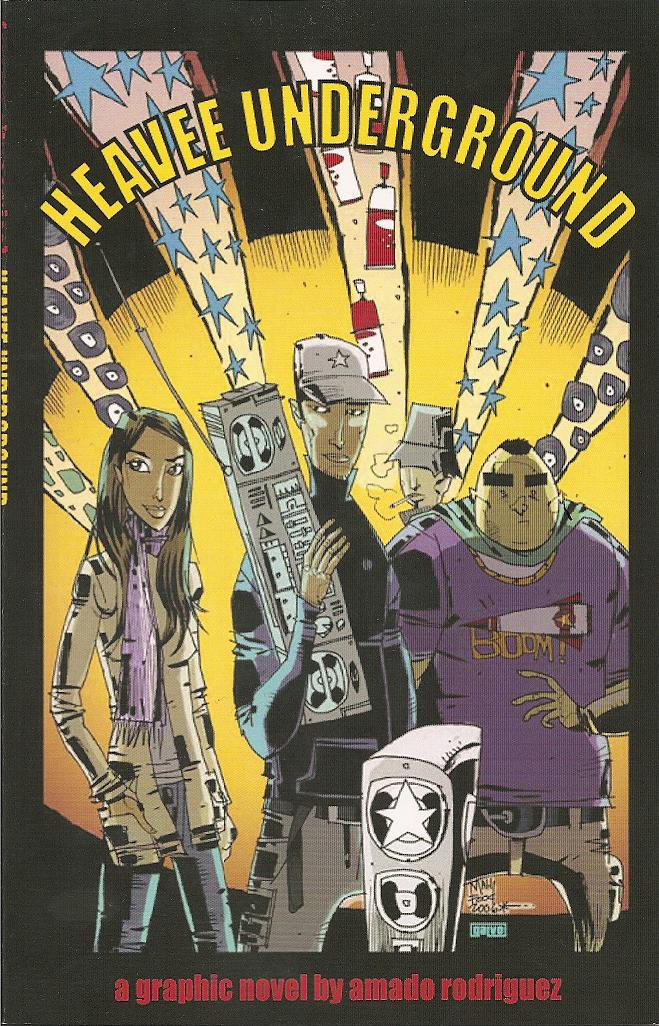
HEAVEE UNDERGROUND OGN
Plot, dialog, art: Amado AREX Rodriguez Additional art: Alberto "Ponbiki" Rios, Tim Irwin Script: Bernie Gonzalez Publisher: Cream City Comics Reviewer: Ambush Bug
One of the things I like most about this here Indie Jones section is that comics that reside in this section of AICN Comics can shed light on cultures and situations that you don't normally see in mainstream comics. HEAVEE UNDERGROUND's roots lay in music and dance. And even if hip hop is not your thing when it comes to music, there's no doubt this book will get you moving and force a new appreciation on the genre of music and the culture that surrounds it.The force behind this book is Amado AREX Rodriguez. I've seen quite a bit of Amado's work and admired it for his abstract way of telling a story. Every panel seems to be well thought out and envisioned through the most creative of lenses. Mainstream comics are often guilty of throwaway panels where the artist half-@$$es it until the big money shot splash page. Here, not a panel is wasted and all stand out artistically as something special.
Storywise, I see a lot of growth as far as cohesion. I like AREX's abstract style, but a bunch of images is just that...a bunch of images. Here these images work well together to tell a very cool story of one man's trek from Milwaukee to Chicago. Slowly, the purpose of this trip is revealed. And of course it's about a girl. Projected onto a background of hip hop music and club dancing, this story is resonant and insightful. AREX's character of Paco goes on a journey of self-discovery and seems to come out of this story wiser and more confident.
On top of AREX's vivid images, a group of other artists contributed to this book, all of them distinct and all of them making their panels energetic and alive. Alberto "Ponbiki" Rios (another talented artist featured in Indie Jones before) draws the final "dance-off" between Paco and his rival, the punk who stole his girlfirend many years ago. Rios' art is different than AREX's, but I liked the change in artistic styles. This change was representative of a change in the main character's character and confidence. Rios' art is loose and alive. The book also features a "remix" chapter at the end--kind of a mish-mash version of the final "dance off" in the story by talented artist Tim Irwin, whose pencils are as vivid and creative and make each panel seem electric. Irwin multi-layers his panels giving the eye a lot to soak in. He's a very talented artist with a confident handle on his subjects.
This book is an art lovers dream. Sure the story is about a "dance off" and cheesy movies like YOU GOT SERVED have made that somewhat laughable. But this book brings back some respect to an underground culture of dancing that is much more substantial than those teenie movies suggest. In this book, dance is a modern version of kung-fu. Dancers square off for the sake of honor. It's a very cool concept made visually electric by AREX and Co.

